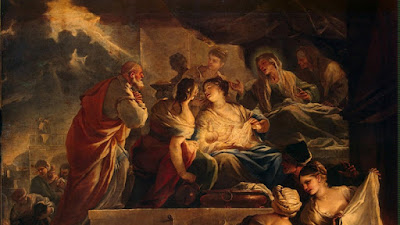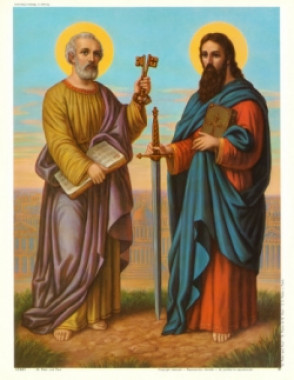Commemoration (1954 Calendar): June 28
The Vigil of Ss. Peter and Paul, like the vigils of the other apostles which used to be days of fasting and preparation, has fallen by the wayside after the changes to the Church's liturgical life even before Vatican II. This particular day of fasting is one of the few remnants of the Apostles Fast, which was instituted by Pope St. Leo the Great in 461.
Part of the reason for preparation was on account of the Feast of Ss. Peter and Paul being a Universal Holy Day of Obligation in many places. In fact, all of the feasts of the Apostles were Holy Days of Obligation on the Universal Calendar from 932 AD - as cited by Father Weiser on page 279 in his "Christian Feasts and Customs" - to 1911. However, most localities did not observe all of these feastdays as Holy Days. The Feast of Ss. Peter and Paul was the most commonly observed Holy Day among the feasts of the apostles.
At the time of America's formation, the holydays of obligation, in addition to every Sunday, were as follows for the new country: the feasts of Christmas, Circumcision, Epiphany, Annunciation, Easter Monday, Ascension, Whitsun Monday, Corpus Christi, Ss. Peter and Paul, Assumption, and All Saints. The fasting days were the Ember Days of each of the seasons; the forty days Lent; Wednesdays and Fridays in Advent; and the vigils of Christmas, Pentecost, Ss Peter and Paul, and All Saints. Abstinence was required on days of fasting as well as Fridays and Saturdays throughout the year. Notice, the Feast of Ss. Peter and Paul as well as the Vigil of Ss. Peter and Paul on the list.
The Vigil of Ss. Peter and Paul ceased being a fast day in America by 1842. Pope Gregory XVI in 1837 dispensed all the dioceses then in the United States from the obligation as to Easter Monday and Whitsun Monday and in 1840 from that of the feast of St Peter and St Paul and the same Sovereign Pontiff relieved the faithful from the fast on Wednesdays in Advent.
Yet it remained as a Holy Day in many other places. Even after the significant changes made by Pope St. Pius X to the list of Holy Days in 1911, Ss. Peter and Paul remained a Holy Day of Obligation in the Universal Church, though it was not reestablished as such in the United States: "Where, however, any of the above feasts has been abolished or transferred, the new legislation is not effective. In the United States consequently the Epiphany and the feast of Sts. Peter and Paul are not days of precept" (Catholic Encyclopedia).
In Great Britain, Ireland, Australia, and Canada the Vigil of Ss. Peter and Paul remained a day of fasting and abstinence up until the 1917 Code of Canon law. In 1902, the Holy Father granted a special dispensation for Catholics in England from fasting on the Vigil of Ss. Peter and Paul in honor of the coronation of King Edward VII, illustrating historical proof of its observance in the early part of the 20th century.
Per the 1917 Code, fasting and abstinence were not observed should a vigil fall on a Sunday as stated in the code: "If a vigil that is a fast day falls on a Sunday the fast is not to be anticipated on Saturday, but is dropped altogether that year." However, beforehand, the fast was observed to the Saturday previous. As a result, in years when the Vigil of Ss. Peter and Paul (June 28th) falls on a Sunday, we can observe the fast and abstinence on Saturday. Other years, we can voluntarily observe June 28th as a day of fasting and abstinence to prepare for the Feast in honor of Ss. Peter and Paul.
The wisdom of Dom Gueranger, written in the late 1800s, can apply to us even today:
Collect:
O Almighty God, let no disturbance upset us, for You have established us upon the rock of Your apostles. Through our Lord . . .
In Great Britain, Ireland, Australia, and Canada the Vigil of Ss. Peter and Paul remained a day of fasting and abstinence up until the 1917 Code of Canon law. In 1902, the Holy Father granted a special dispensation for Catholics in England from fasting on the Vigil of Ss. Peter and Paul in honor of the coronation of King Edward VII, illustrating historical proof of its observance in the early part of the 20th century.
Per the 1917 Code, fasting and abstinence were not observed should a vigil fall on a Sunday as stated in the code: "If a vigil that is a fast day falls on a Sunday the fast is not to be anticipated on Saturday, but is dropped altogether that year." However, beforehand, the fast was observed to the Saturday previous. As a result, in years when the Vigil of Ss. Peter and Paul (June 28th) falls on a Sunday, we can observe the fast and abstinence on Saturday. Other years, we can voluntarily observe June 28th as a day of fasting and abstinence to prepare for the Feast in honor of Ss. Peter and Paul.
The wisdom of Dom Gueranger, written in the late 1800s, can apply to us even today:
Let us, then, recollect ourselves, preparing our hearts in union with holy Church, by faithfully observing this vigil. When the obligation of thus keeping up certain days of preparation previous to the festivals is strictly maintained by a people, it is a sign that Faith is still living amongst them; it proves that they understand the greatness of that which the holy liturgy proposes to their homage. Christians in the West, we who make the glory of Saints Peter and Paul our boast, let us remember the Lent in honour of the Apostles begun by Greek schismatics on the close of the Paschal solemnities, and continued up to this day. The contrast between them and ourselves will be of a nature to stir softness and ingratitude hold too large a share. If certain concessions have, for grave reasons, been reluctantly made by the Church, so that the fast of this vigil is not longer observed, let us see therein a double motive for holding fast to her precious Tradition. Let us make up by fervor, thanksgiving and love, for the severity lacking in our observance, which is yet still maintained by so many Churches notwithstanding their schismatic separation from Rome.While the Vigils of the other Apostles were removed by Pope Pius XII in 1955, the Vigil of Ss. Peter and Paul remained and is preserved in the 1962 Missal. At the time of the formation of the Tridentine Calendar, the Vigil of Ss. Peter and Paul was commemorated on June 28th as it fell on the Feast of St. Leo II. In 1921, the Feast of St. Leo II was moved to July 3rd, and St. Irenaeus was added to the Universal Calendar on June 28th; the Vigil of Ss. Peter and Paul remained commemorated. However, in 1960, St. Irenaeus was moved to July 3rd, and St. Leo II disappeared from the Calendar to free up the 28th entirely for the Vigil. Sadly, the vigil disappeared altogether in the Novus Ordo 1969 Calendar. Therefore, how the Vigil is celebrated or commemorated on June 28th will depend on the year of the Missal. You can read more about the liturgical feasts on June 28th at the New Liturgical Movement.
Collect:
O Almighty God, let no disturbance upset us, for You have established us upon the rock of Your apostles. Through our Lord . . .
















